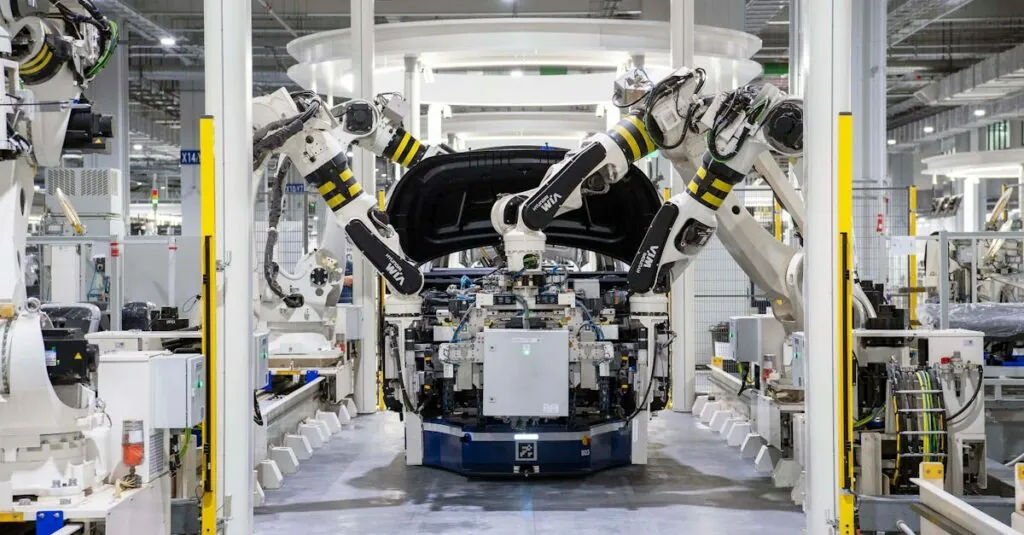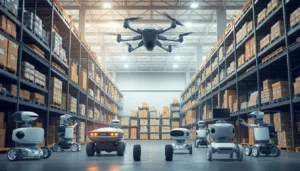In today’s fast-paced world, industrial automation and robotics are more than just buzzwords; they’re the superheroes of modern manufacturing. Imagine a factory floor where machines don’t just work harder but smarter, making those 9-to-5 grind hours feel like a thing of the past. With robots stepping in to handle the heavy lifting—literally—humans can finally focus on the creative, strategic tasks that require a little more brainpower and a lot less bicep.
Table of Contents
ToggleOverview of Industrial Automation and Robotics
Industrial automation and robotics play a significant role in transforming manufacturing processes. Enhanced intelligence in machines allows a smooth transition from manual labor to more strategic tasks for human workers.
Definition and Key Concepts
Industrial automation refers to the use of control systems for operating equipment in manufacturing facilities. These systems include machinery, processes, and even entire production lines. Robotics involves the design and application of robots, which perform specific tasks. Organizations often integrate automated systems with robotics to improve efficiency. Common elements in this field include programmable logic controllers (PLCs), sensors, and robots, all working synchronously to optimize production.
Importance in Modern Industry
Modern industry relies heavily on automation and robotics for various reasons. Increased productivity is a primary benefit, as machines operate continuously without fatigue. Enhanced precision in manufacturing processes reduces errors and waste. Cost savings emerge from lower labor costs and decreased production times. Furthermore, automation boosts safety by taking over dangerous tasks, minimizing risk to human workers. Companies adopting these technologies position themselves to compete effectively in the global market.
Types of Industrial Automation
Industrial automation encompasses multiple systems and approaches that optimize manufacturing processes. Each type serves specific operational needs and can significantly impact efficiency and productivity.
Fixed and Flexible Automation
Fixed automation utilizes equipment designed for a specific task. This type often appears in high-volume production scenarios, delivering speed and consistency. Flexible automation, on the other hand, offers adaptability and reconfiguration ability. It suits environments with varying product types, allowing organizations to switch production lines quickly. While fixed automation excels in consistency, flexible automation embraces diversity in production methods.
Industrial Robotics Systems
Industrial robotics systems vary in design and application, targeting specific tasks in manufacturing. Common examples include robotic arms used for assembly, welding, and packaging. These robots integrate advanced sensors and control systems to enhance precision. Additionally, collaborative robots, or cobots, work alongside human workers, promoting safety and efficiency. The versatility of these systems addresses diverse operational needs, significantly improving productivity and reducing human error across industries.
Applications of Industrial Automation and Robotics
Industrial automation and robotics find vital use in various sectors, transforming workflows and enhancing productivity.
Manufacturing Processes
Automation streamlines manufacturing processes by incorporating robotic systems for tasks such as assembly, welding, and material handling. Robotics enhances multitasking capabilities, enabling machines to perform complex operations with precision. For instance, automotive manufacturers utilize robotic arms to improve assembly line efficiency, achieving high-volume production rates. Additionally, automation reduces cycle times, allowing companies to respond swiftly to market demands while minimizing waste. Factories equipped with advanced robotics often show significant reductions in human error, further boosting output quality.
Supply Chain Management
Robotic solutions optimize supply chain management by automating warehousing operations, including order processing and inventory control. Automated storage and retrieval systems enhance efficiency, improving stock accuracy and reducing retrieval times. Companies like Amazon employ robotics to fulfill orders rapidly, enabling faster shipping times. Furthermore, real-time data analytics helps organizations monitor supply chain performance, allowing for proactive decision-making. Automation in logistics not only cuts operational costs but also enhances customer satisfaction through timely delivery and accurate order fulfillment.
Benefits of Implementing Automation and Robotics
Implementing automation and robotics offers notable advantages in the industrial sector, enhancing various operational aspects.
Increased Efficiency and Productivity
Increased efficiency and productivity stem directly from automation’s ability to streamline processes. Robots perform repetitive tasks rapidly, reducing the time needed for production cycles. Moreover, they work continuously without fatigue, ensuring output consistency. Companies utilizing automation often report productivity gains of 20% to 50%, allowing for higher output levels. Enhanced data analytics capabilities further enable process optimization, leading to better decision-making and workflow improvements.
Cost Reduction and Quality Improvement
Cost reduction occurs as automation minimizes labor costs and reduces waste. Estimates suggest that businesses can lower operational expenses by up to 25% through automated systems. Quality improvement ensures products meet high standards consistently, decreasing defects and returns. Automation technologies provide precise measurements and adherence to specifications, maintaining stringent quality controls. Companies experience substantial savings in rework and material costs due to these enhancements. Ultimately, these financial benefits contribute to a more competitive positioning in the market.
Challenges and Considerations
Industrial automation and robotics present various challenges that organizations must navigate to realize their potential benefits.
Workforce Implications
Implementing automation affects workforce dynamics significantly. Concerns about job displacement arise as machines take over repetitive tasks. Although robots enhance productivity, they can lead to shifts in employment needs, demanding workers to adapt and acquire new skills. Training programs play a crucial role in preparing employees for these changes, addressing the gap in expertise. Companies that invest in reskilling their teams foster a more agile workforce, positioning themselves to leverage automation’s capabilities effectively.
Integration with Existing Systems
Integrating automation technologies with existing infrastructure poses technical challenges. Compatibility issues can arise when new robotic systems connect with legacy equipment. Organizations must evaluate their current technology stack to ensure seamless integration. Failing to address these challenges might hinder operational efficiency. Strategic planning and gradual implementation of automation systems facilitate smoother transitions, minimizing disruptions. Companies often benefit from engaging professionals who specialize in system integration, ensuring effective communication between new and existing systems.
Future Trends in Industrial Automation and Robotics
Emerging trends in industrial automation and robotics vary significantly, driven by rapid technological advancements.
Advancements in AI and Machine Learning
Innovations in artificial intelligence and machine learning are transforming automation capabilities. Systems now leverage algorithms to analyze data patterns, improving decision-making processes in real-time. Machines equipped with AI can adapt to changing conditions, enhancing operational efficiency across various sectors. For instance, predictive maintenance uses AI to foresee equipment failures, reducing downtime significantly. Companies can achieve up to 20% less maintenance cost through these AI-driven insights. Implementing sophisticated machine learning models fosters continuous improvement, enabling organizations to navigate complex manufacturing challenges effectively.
Impact of IoT on Automation
The integration of the Internet of Things into automation profoundly impacts industrial processes. Devices interconnected through IoT collect and exchange invaluable data, providing organizations with real-time insights. Enhanced visibility into operational workflows enables businesses to streamline production lines. For instance, obtaining live data from machinery helps managers optimize resource allocation and improve productivity. Adopting IoT solutions can lead to a 30% reduction in operational inefficiencies observed in studies. Through this interconnected framework, companies maximize automation’s potential while ensuring responsiveness to market demands.
The rise of industrial automation and robotics is reshaping the landscape of manufacturing and beyond. As organizations embrace these technologies, they unlock new levels of efficiency and productivity that were previously unattainable. The shift away from repetitive tasks allows human workers to engage in more strategic and innovative roles, fostering a more dynamic work environment.
While challenges such as workforce displacement and integration complexities exist, the benefits far outweigh the drawbacks. Companies that invest in automation and robotics not only enhance their competitive edge but also improve customer satisfaction through optimized operations. As advancements in AI and IoT continue to drive innovation, the future of industrial automation promises even greater possibilities for growth and efficiency.










